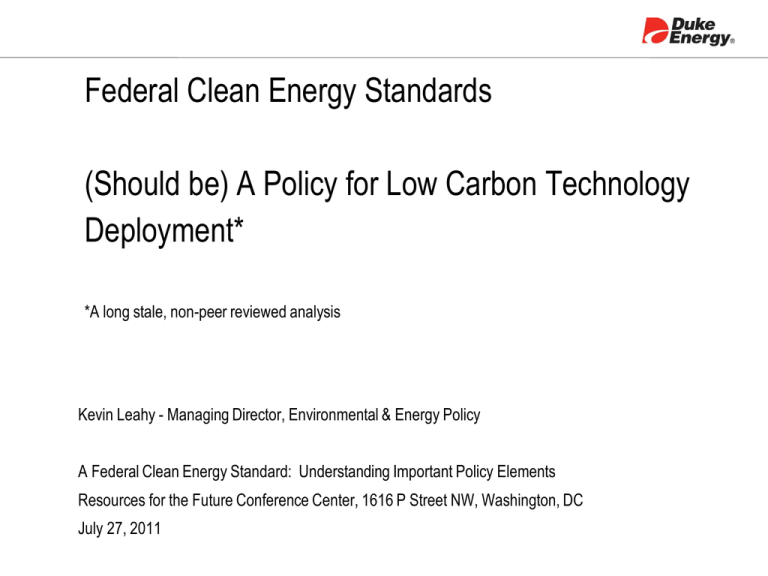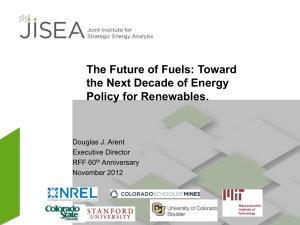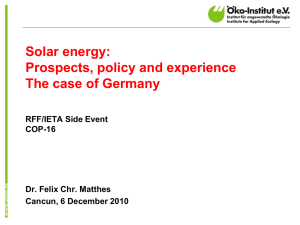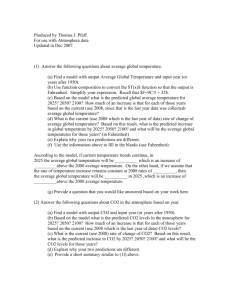Federal Clean Energy Standards Deployment*
advertisement

Federal Clean Energy Standards (Should be) A Policy for Low Carbon Technology Deployment* *A long stale, non-peer reviewed analysis Kevin Leahy - Managing Director, Environmental & Energy Policy A Federal Clean Energy Standard: Understanding Important Policy Elements Resources for the Future Conference Center, 1616 P Street NW, Washington, DC July 27, 2011 U.S. FRANCHISED ELECTRIC AND GAS 5 states: North Carolina, South Carolina, Indiana, Ohio and Kentucky 50,000 square miles of service area 27,000 MW of regulated generating capacity 4.0 million retail electric customers 500,000 retail gas customers in the Cincinnati area 3rd largest coal consumer & nuclear operator in U.S. 2 Pending acquisition of Progress Energy will make us largest utility in U.S -- approximately mirror U.S. portfolio Very roughly: 1,000 MW (1 GW) can power 1 million homes 3 Background Our Beliefs Risk of CO2 limits continues to influence the market (no new coal build out) Now a political non-starter Dormant, not dead The direction of EPA CO2 regulation is unclear Low carbon technology development /deployment (especially nuclear & CCS) will stall without a policy driver. Left and Right gloating over AEP’s CCS closure Possible Policy Initiatives for Low Carbon Technology Development Federal or state loan guarantees Federal or state tax credits Federal or state grants R&D wire charges or fuel surcharges Expanded State renewable portfolio standards to include CCS and nuclear Federal renewable/clean energy standards EPA BACT CO2 Regulation 4 Policy Framing is Critical -- will impact the speed with which issue can be advanced Emissions or technology focused? Congress in no mood to deal with GHG emissions Advocates need to convince the public the issue matters – politicians afraid to defend (let alone advance) climate Public generally supportive of new clean energy technologies Though Conservative/Libertarian thought leaders attack government support as wasteful support of rent seekers Still easier to support than climate, so more likely to go first A carbon policy cloaked in technology won’t fool anyone unless pols want to use it as way to discretely support climate (and few do now) Opponents already call any hint of a carbon policy a remake of Waxman Markey Electricity Sector Was Banking on Nuclear and CCS – 2009 point of view (w/higher nat gas prices) 7 7 Oil Hydro Biomass Demand with No Policy Retrofit Gas Nuclear Wind Solar Demand Reduction Limited Portfolio 5 Trillion kWh per year New CCS Demand Reduction Full Portfolio Demand Reduction Nuclear 3 Wind 3 Hydro Nuclear Gas 2 2 Gas 1 Coal 0 2000 2010 Coal 2020 2030 2040 2050 2000 New Coal + CCS CCS Retrofit 2010 2020 2030 2040 • Full portfolio was 80% less costly than limited portfolio • (not shown above) Low natural gas prices give industry more time, but don’t change long term tech requirements 6 4 Hydro Biomass Wind 5 Biomass Solar 4 6 EPRI’s 2009 update 1 0 2050 Trillion kWh per year 6 Coal 2010/11 Senate Proposals As an alternative to carbon regulation, Senators Lugar and Graham introduced separate bills that included a Diverse or Clean Energy Standard Included aggressive long-term targets – 50% energy from new low emitting sources by 2050, i.e., renewables, nuclear and CCS Intended as a practical alternative to carbon regulation (Lugar said as much when he introduced it) Duke Energy modeled each proposal using ICF’s IPM, later modified to approximate the WH framework 7 Electric Industry’s Compliance Scenario Will be determined by each utility with approval of state utility commission Very generally, CES modeling of U.S. electricity system with $50 CEC price indicates: Years 1-5 significant build of new wind turbines to satisfy near term demand for Clean Energy Certificates -- CECs (due to cost and rapid deployment capability) Years 1-10 Industry begins building nuclear and CCS units (5,000 MW new nuclear & 3,500 MW CCS by 2020 (nationwide) Consistent with technology deployment industry anticipated with the CO2 limits However … If policy inadvertently dilutes demand or inflates supply of CECs, CEC prices will be too low to incentivize robust clean technology deployment and will strand an aggressive base load build-out Example: White House inclusion of natural gas may undermine investment in new technologies by dramatically lowering price of CECs 8 CO2 vs. Tech Standards -- Fundamentally Different Senate CES proposals = Technology Focus CES is economically efficient driver of new technologies (technology focus) CES less efficient at reducing emissions – cost/ton reduced is much higher Flattens CO2 growth, little decline at higher equivalent cost/ton Lugar policy good at driving wind, nukes and CCS pre-2030 Lugar less ambitious than CO2 policies (WM) post 2030 – 50% 2050 target compared to near complete fleet turnover with CO2 price Can drive same small rate increase across entire country Emission focus CO2 price more efficient at reducing CO2 emissions – significantly lower cost/ton and easier to include other sectors CO2 policy *(WM like targets) drives more technology in long run owing to stiffer 2050 targets CO2 price drives greater fuel switching in first decades CO2 legislation would likely have included Clean Air Act Preemption (no NSR problems for CO2) – won’t get this with RPS/CES policy Will drive very different rate impacts – regional winners and losers Senate CES needed to keep new techs alive but is only a partial CO2 solution 9 What we modeled Lugar – 50% energy from NEW clean sources by 2050 (new plants), $50 ACP, summer 2010 EEI assumptions for criteria pollutants Graham – similar targets, exempt small distcos, carve outs for particular techs, $35 ACP, Dec EEI assumptions (harder still) Modified Graham to eliminate exemptions and carve outs to push CEC price higher WH framework Graham targets + ½ CEC for natural gas (no WH details available) Graham and Lugar required power from NEW clean energy sources WH apparently would include existing clean sources (efficient policy!) with nominally steeper targets – 80% energy from clean by 2030s WH – 80% target in ballpark of double today’s level – directionally similar to Senate 50% clean target 10 Very Rough Comparison of Requirements WH & Senate Frames (spreadsheet) 160.0 Total Energy Demand (0.8% growth) 140.0 New Tech from WH version Baseline (100 = today's load) 120.0 New Tech from CO2 cap (approx) 100.0 80.0 New Tech from Senate Version 60.0 *Assumptions: 1) no increased gen from existing clean sources -- bias WH & CO2 Cap lines higher 2) no clean sources retire post 2010 - bias all "new sources" lines lower 40.0 20.0 0.0 2010 2015 2020 2025 2030 2035 2040 2045 2050 11 Implications for the Utility Industry (SAMPLE ONLY – THIS IS FROM LAST FALL’s LUGAR ANALYSIS -- $50 ACP) Total Capacity Build By Technology and Scenario (IPM output) 350,000 Nuclear deploys equally with CES and CO2 (zero with no policy case) CCS deploys pre-2025 with CES (CO2 has zero pre-2025) 300,000 MW 250,000 200,000 Natural gas deploys less with CES & CO2 compared to the no policy case of 375K MW by 2040 (Solid Line) Coal retirements happen in all cases, nearly all by 2025 – CES is middle impact Wind deploys faster pre-2025 with CES CO2 much larger CCS 150,000 100,000 50,000 2040 2025 Nuc CO2 & CES 38,660 15,240 CCS CO2 CCS CES Wind CO2 Wind CES NG CO2 NG CES 117,770 - 21,156 10,034 62,336 58,953 35,862 84,828 191,295 113,493 160,211 109,101 Coal Ret Base Coal Ret CO2 Coal Ret CES 20,750 18,437 72,842 1,354 48,500 12 Graham & WH frames less potent tech drivers CEC prices too low due to: Exemptions for small utilities weaken overall demand Carve outs for select technologies (solar) increase supply Only hit $35 ACP if eliminate both $35 too low to incent nuclear or CCS until later decades Good wind and solar driver CES drives less natural gas deployment than the BAU case (which shows N.G. is the new default technology) CES decreases future share from natural gas WH has similar CEC low price problem Amplifies an already strong natural gas deployment Still solid wind and solar deployment No CCS, few nukes beginning 2040 13 Graham vs. WH – Natural Gas Combined Cycle NGCC Deployment (MW) 2005 2010 2015 2020 2025 2030 2035 2040 2045 2050 2055 450,000 250,000 400,000 200,000 350,000 300,000 150,000 250,000 NGCC + NG (1/2 credit) NGCC CES 200,000 100,000 NGCC (no policy) 150,000 100,000 50,000 50,000 - 2005 2010 2015 2020 2025 2030 2035 2040 2045 2050 2055 Surprise! Model shows CCS on NG around 2025 for CES (none for WH frame though) 14 Graham vs. WH – New Nuclear Capacity (No CCS on coal) Nuclear Deployment (MW) 25,000 20,000 15,000 Nuclear (no policy) Nuclear CES Nuclear (NG at 1/2 credit) 10,000 5,000 2011 2013 2014 2016 2018 2020 2025 2032 2040 2045 2050 15 Fossil Generation By Fuel Source (GWh) 2,500,000 2,000,000 1,500,000 Coal Gen (no policy) Coal Gen CES Coal Gen (CES with NG) NG CES at 1/2 credit NG no policy 1,000,000 NG CES 500,000 2005 2010 2015 2020 2025 2030 2035 2040 2045 16 Wind Generation (GWh) with Coal Comparison 2,500,000 2,000,000 1,500,000 Coal Generation (base case) Wind CES Wind (NG at 1/2 credit) Wind (base case) 1,000,000 500,000 2010 2015 2020 2025 2030 2035 2040 2045 2050 17 Solar Generation (GWh) compared to Wind Base Case 350,000 300,000 250,000 200,000 Wind (Base Case) Solar CES (NG at 1/2 credit) Solar CES 150,000 Solar Base Case 100,000 50,000 2005 2010 2015 2020 2025 2030 2035 2040 2045 18 Tons CO2 Emitted (million tons/year) 3,000 2,500 2,000 No Policy Case 1,500 CES CES w/NG at 1/2 credit 1,000 500 2010 2015 2020 2025 2030 2035 2040 2045 2050 19 Scale of Consumer Impacts of Different Frames (rough spreadsheet analysis) KWh adder (¢/KWh) -- low emitting vs. coal state example 4.50¢ 4.00¢ 3.50¢ 3.00¢ 2.50 ¢ ¢/KWh 2.50¢ WH (coal state -- very rough) 2.00¢ Lugar ($50 ACP) 1.50 ¢ 1.50¢ 0.75 ¢ 1.00¢ 1.75 ¢ 1.25 ¢ WH (clean state -- very rough) 1.00 ¢ .50¢ 0.70 ¢ 0.53 ¢ .00¢ 2015 2020 0.88 ¢ 2025 Graham ($35 ACP) 1.05 ¢ 2030 2035 2040 2045 2050 -.50¢ -1.00¢ 20 Q: Is CES all that’s needed? A: Probably not Big multi-billion dollar projects with innovative techs still have experience curves – costs decline/performance improves with each additional copy – this is typically a barrier to first movers Nuclear: Strong, long term federal financing support is required for initial projects Cost over-run protection Timely recovery – Federal incentives to encourage states to approve CWIP New federal financing source, with reduced political risks (remove from federal budget process) Streamline NRC permitting/licensing Several of these components were in last year’s Kerry/Graham/Lieberman draft legislation Clean Coal/CCS Sustained funding for first 5 to 10 projects to fully develop the technology (brine sequestration is key) Liability protection, streamlined permitting under SDWA, pore space policy with components from last year’s Rockefeller-Voinovich proposal Transmission Coordination of planning, development and citing Energy Efficiency Federal incentives to encourage states to advance/approve utility based EE programs Transportation Sector Incentives (EV, CNG) – Lugar contained transport section in his draft bill Above list is not all inclusive – other ideas may emerge 21







